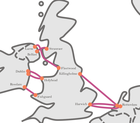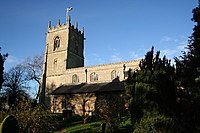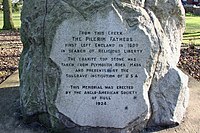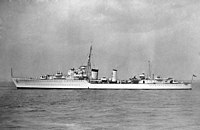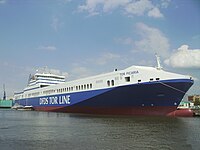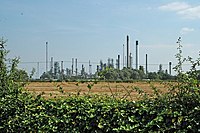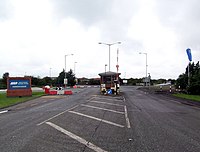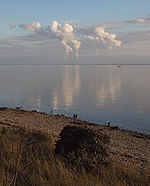Immingham
| Immingham | |
| Lincolnshire | |
|---|---|
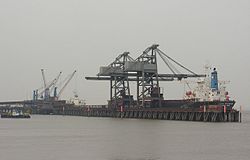 Immingham Bulk Terminals | |
| Location | |
| Grid reference: | TA178145 |
| Location: | 53°36’50"N, 0°13’6"W |
| Data | |
| Population: | 12,200 |
| Post town: | Immingham |
| Postcode: | DN40 |
| Dialling code: | 01469 |
| Local Government | |
| Council: | North East Lincolnshire |
| Parliamentary constituency: |
Cleethorpes |
Immingham is a port town in Lincolnshire, standing on the south bank of the Humber Estuary. It is in Lindsey, six miles north-west of Grimsby. It is sometimes known locally as Ming-Ming[1] or simply Ming.
Immingham is sandwiched between the A180 to the south and the A1173 to the north, which is also the access road between both gates of the port.
The mediæval village of Immingham is on the outskirts of the town to the north-west near St Andrew's Church.
To the north-west is South Killingholme. In the east is the mediæval village of Roxton, now part of Immingham. The south-west corner of the parish takes in the east of Roxton Wood, extending as far south as New Beck Drain.
Contents
Shipping routes
The European road route E22 apparently passes "through" Immingham; this actually refers to the nearby route of the A180 and the A160 by way of Immingham Dock and thence on to Amsterdam which implies there is a ferry to Amsterdam: there is none. Freight transport may sail from Immingham Dock to:
- Gothenburg in Sweden
- Esbjerg in Denmark
- Cuxhaven in Germany
- Rotterdam in the Netherlands (the mysterious Route E22
Sailings go from the DFDS Nordic Terminal, which has six roll-on / roll-offberths
Another route is from Killingholme's Humber Sea Terminal to from the Hook of Holland.
Name of the town
The name of Immingham is from Old English, which is unusual in an area of Lincolnshire noted for names derived from the later Norse settlers. The name Immingaham means "home of Imma's clan".
Bede mentions a Northumbrian nobleman called Imma, who fought in the Battle of the Trent in 679, though any connection with that particular Imma is purely speculative.
History
Imma
One Imma is known to history, who might have founded the town, though we will never know. Bede tells us that in 679 Imma was a Thane in the service of the 18-year-old brother of the King of Northumbria, Aelfwine. In the Battle of the Trent in 679, Aelfwine was slain and Northumbria lost control of Lindsey, where Immingham is found.
Imma was left for dead on the field. He later revived and was taken into captivity (being careful to keep his name and title secret). The Mercians who had captured him treated his wounds and when he got better chained him up each night to prevent his escape. Meanwhile, his brother, Tunna, a priest and abbot of a monastery, assuming his brother dead, had regular prayers and masses said for him.
The Mercians had great trouble keeping Imma in captivity and guessed he was more than just a peasant. The Mercian Chief had him closely questioned. Imma agreed to speak if the Chief promised not to kill him. On learning that Imma was a King’s Thane he was furious but could not go back on his word. The Mercians believed Imma was using magic to escape. But Imma pointed out that his brother was Christian and was probably praying for him and that was the reason for his near-success.
Because he was such a problem the Mercians sold Imma in London as a slave to a Frisian. This Frisian also found it difficult to keep Imma captive so he allowed him to arrange for his ransom. The King of Kent eventually paid the ransom because he had connections with Imma’s family. Imma went through a number of other adventures before he got back to his own country. On reuniting with his brother, the abbot confirmed that he had indeed been praying for his brother.[2]
Pilgrim Fathers
The town contains a memorial] marking the site of the 1608 departure of the Pilgrim Fathers to the Netherlands. The vessel anchored off Killingholme Creek but suffered very bad weather. Due to this the wives asked to be put ashore for the night. The vessel was sailed up Killingholme Creek to just below St. Mary's Parish Church in Immingham - a small depression probably marking this site can still be distinguished at the end of Washdyke Lane. The inhabitants of Immingham agreed to the wives and children sleeping in their parish church over night. Unfortunately news of this group reached the authorities who proceeded to come to Immingham and arrest the dessenters. On hearing this, the captain of the vessel insisted on sailing away before the wives and children could embark. Hence the wives and children were arrested and jailed. Word of this spread throughout the country and very soon a popular protest against this inhumane treatment arose. Due to this popular feeling the wives and children were released and allowed to join their husbands and fathers in the Netherlands.[3][4] The vessels sailed to Boston and on to the Netherlands, then to Southampton and finally Plymouth, from where history records the sailings of the Mayflower. From 12 July 2008 until 19 July 2008, the town held a number of celebrations to mark the 400th anniversary of the Pilgrim Fathers' arrival and departure.
World wars
During the First World War, Immingham was a submarine base for early submarines.
During the Second World War, Immingham became the shore base (for a time) of Lord Mountbatten and the docks hosted his famous vessel, HMS Kelly. He lodged at the County Hotel.
Squadron Leader John Dowland and Leonard Harrison received the George Cross for defusing a bomb that had fallen onto the grain ship SS Kildare in February 1940 in Immingham Dock.
The Humber Force, part of the Home Fleet which had two cruisers and a destroyer flotilla (including HMS Afridi) was based at Immingham during the war, as well as submarines (including HMS Seal).
Maritime industry
Up until the turn of the 20th century Immingham was a rural village, dependent on agriculture. The advent of the railways encouraged speculators to utilise its location on the coast to build a deep-sea dock to rival that in nearby Hull.
This caused the area to grow as workers moved in; much of the growth in living accommodation was centred around in a narrow strip (now known as Pelham Road) between two public houses at opposite ends of the town, the Bluestone and the County Hotel. The advent of the First World War caused the area to suffer some decline: This was not reversed until the 1950s.
Petrochemical industry
In that decade the docks began to grow as the country recovered from the austerity of the Second World War and the post war years. The expansion of chemical and petroleum industries along the Humber Bank over the next twenty years also fuelled the economic growth and level of population of the town, evident in the architectural style of many houses. This new residential growth expanded on both sides of Pelham Road and in the 1960s a comprehensive school and shopping centre/office complex (Kennedy Way) were opened to facilitate this increase.
Local industry
Along with Grimsby and Cleethorpes, Immingham is part of the economic area known as "Greater Grimsby".[5] Which, in turn form part of the wider economic partnership of The Hull and Humber Ports City Region[6] The main sectors of the Greater Grimsby economy are food and drink; ports and logistics; renewable energy; chemicals and process industries and digital media. Along the A1173 is the Knauf UK GmbH plant that makes plasterboard.
Port of Immingham
As at 2008, the Port of Grimsby and Immingham was the UK’s largest port by tonnage,[7] owned by Associated British Ports, and is a constituent port on the Humber. Its prime deep-water location on the Humber Estuary, gives companies direct access to Europe and beyond.
The first sod of Immingham Dock was cut in 1906, and was opened by King George V on 22 July 1913. In part funded by the Great Central Railway, the dock property was 2½ miles by a mile; covering 1,000 acres, with 45 acres of water.[8] The docks were connected to the town and mainline by the Grimsby & Immingham Electric Railway, with locomotive servicing at Immingham TMD.
Now owned by Associated British Ports, Immingham is home to the largest deep-sea docks in the country. A large port and industrial complex, coal is imported through the port by SSM Coal Ltd]. The port partnership of Grimsby & Immingham is the largest port in the UK in terms of tonnage, with a total traffic of 57 million tons, 10% of the total, in 2006. Much overseas coal for the Aire Valley and Trent Valley power stations arrives in this country at Immingham and is transferred by FirstGBRf. The large Immingham Railfreight Terminal to service the docks, also acts as a storage point for excess locomotives and wagons, as well as a scrapping location.
Energy
Close to Immingham, oil is refined at the Lindsey (at North Killingholme) Oil Refinery by TOTAL and at the Humber Refinery (at South Killingholme) by ConocoPhillips. They both own the Associated Petroleum Terminals. Oil began to be imported in 1970. The Killingholme Refineries opened in 1969, owned by Total and PetroFina. The refined fuel was transported to the rest of the UK by rail. 70% of the refined oil from the Humber Refinery goes to the UK, the rest is for Europe. It is the only coking refinery in Britain, produced by catalytic cracking. In the second half of 2007, an £80m bioethanol fuel plant will be constructed close to the town. The plant will use locally-grown wheat from which to synthesise fuel.[9]
Immingham Power Station powers both petrochemical works to the north, being owned by ConocoPhillips. To the north of the petrochemical works is Killingholme Power Station owned by E.ON UK and Centrica and three miles to the east on the Humber bank is the South Humber Bank Power Station, owned by Centrica. In April 2009 Drax Power held public exhibitions in the area that detailed their proposal for a 300MW renewable energy plant to be fuelled by biomass.
Digital media
Immingham is at the heart of the emerging centre of digital media in "Greater Grimsby", with award-winning companies and state-of-the-art facilities. Partnerships with Sony, BBC, ITV and the Press Association enable the area to deliver programming that reaches millions across Europe.[10] Immage Studios is a state-of-the art media centre and hub of creative TV, broadcast technology and new media innovation. The studios, based in Immingham and owned by the Grimsby Institute of Further and Higher Education, consist of a 2,700 square-foot broadcast TV studio with full support, HD edit suites and a digital broadcast transmission facility. The studio building is home to Propeller TV and Channel 7 Television and outputs over 3,500 hours of broadcast programming a year to the Sky satellite and Virgin Media cable platforms.
Outside links
- The parish church
- Port of Immingham
- Immingham.org.uk
- Immingham Town Council
- Real-time location of ships in Immingham Dock
- Busiest ports in the country
- Immingham south bank players
- Immingham Golf Club
Video clips
- Town council
- Immingham News
- Shipping traffic in Immingham Dock viewed from ASD Tug Laura with time-lapse film compression
References
- ↑ British Antarctic Survey - 26 October 2002 - Arrival in Immingham
- ↑ Bede: The Ecclesiastical History of the English Nation Book IV, Chapter XXII
- ↑ Chris Sharp, August/September 2001 issue of British Heritage
- ↑ "The Pilgrims’ Faith" by Peter Toon, Gospel Communication, 1970
- ↑ Business Welcomes Rebrand This is Grimsby
- ↑ The Hull and Humber Ports City Region North Lincolnshire Council
- ↑ Grimsby remains UK’s largest port Road Transport, 3 June 2008
- ↑ Immingham Lincolnshire & East Yorkshire Transport Review
- ↑ Centaur welcomes £80m biofuels boost for local farmers Farming UK
- ↑ Immage Studios The Grimsby Institute of Further & Higher Education
